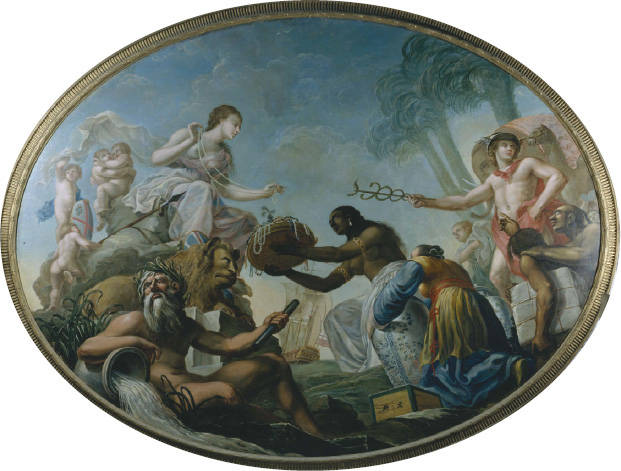The East India Companies
Change
Question
To what extent did the British and Dutch trading companies change the societies they encountered in Asia?
[Answer Question]
Far more important than the Spanish as European competitors for the spice trade were the Dutch and English, both of whom entered Indian Ocean commerce in the early seventeenth century. Together they quickly overtook and displaced the Portuguese, often by force, even as they competed vigorously with each other as well. These rising Northern European powers were both militarily and economically stronger than the Portuguese. During the sixteenth century, the Dutch had become a highly commercialized and urbanized society, and their business skills and maritime shipping operations were the envy of Europe. Around 1600, both the British and the Dutch, unlike the Portuguese, organized their Indian Ocean ventures through private trading companies, which were able to raise money and share risks among a substantial number of merchant investors. The British East India Company and the Dutch East India Company received charters from their respective governments granting them trading monopolies and the power to make war and to govern conquered peoples. Thus they established their own parallel and competing trading post empires, with the Dutch focused on the islands of Indonesia and the English on India. Somewhat later, a French company also established settlements in the Indian Ocean basin.
Operating in a region of fragmented and weak political authority, the Dutch acted to control not only the shipping but also the production of cloves, cinnamon, nutmeg, and mace. With much bloodshed, the Dutch seized control of a number of small spice-producing islands, forcing their people to sell only to the Dutch and destroying the crops of those who refused. On the Banda Islands, famous for their nutmeg, the Dutch killed, enslaved, or left to starve virtually the entire population of some 15,000 people and then replaced them with Dutch planters, using a slave labor force to produce the nutmeg crop. One Indonesian sultan asked a Dutch commander, “Do you believe that God has preserved for your trade alone islands which lie so far from your homeland?”6 Apparently they did. And for a time in the seventeenth century, the Dutch were able to monopolize the trade in nutmeg, mace, and cloves and to sell these spices in Europe and India at fourteen to seventeen times the price they paid in Indonesia.7 While Dutch profits soared, the local economy of the Spice Islands was shattered, and their people were impoverished.

The Dutch East India Company also established itself briefly on the large island of Taiwan, off the coast of southern China, between 1624 and 1662, hoping to produce deerskins, rice, and sugar for export. Finding the local people unwilling to take part in commercial agriculture, the Dutch opened the island to large-scale Chinese immigration. Thus under a regime of Dutch and Chinese “co-colonization,” Taiwan became ethnically Chinese. Later in the century, Chinese forces expelled the Dutch, bringing Taiwan into China politically as well. And so Taiwan emerged as a place of intersection between European and Chinese expansion in the early modern era.8
The British East India Company operated differently than its Dutch counterpart. Less well financed and less commercially sophisticated, the British were largely excluded from the rich Spice Islands by the Dutch monopoly. Thus they fell back on India, where they established three major trading settlements during the seventeenth century: Bombay (now Mumbai), on India’s west coast, and Calcutta and Madras, on the east coast. Although British naval forces soon gained control of the Arabian Sea and the Persian Gulf, largely replacing the Portuguese, on land they were no match for the powerful Mughal Empire, which ruled most of the Indian subcontinent. Therefore, the British were unable to practice “trade by warfare,” as the Dutch did in Indonesia.9 Rather they secured their trading bases with the permission of Mughal authorities or local rulers, with substantial payments and bribes as the price of admission to the Indian market. When some independent English traders plundered a Mughal ship in 1636, local authorities detained British East India Company officials for two months and forced them to pay a whopping fine. Although pepper and other spices remained important in British trade, British merchants came to focus much more heavily on Indian cotton textiles, which were becoming widely popular in England and its American colonies. Hundreds of villages in the interior of southern India became specialized producers for this British market.
Like the Portuguese before them, both the Dutch and English became heavily involved in trade within Asia. The profits from this “carrying trade” enabled them to purchase Asian goods without paying for them in gold or silver from Europe. Dutch and English traders also began to deal in bulk goods for a mass market—pepper, textiles, and later, tea and coffee—rather than just luxury goods for an elite market. In the second half of the eighteenth century, both the Dutch and British trading post empires slowly evolved into a more conventional form of colonial domination, in which the British came to rule India and the Dutch controlled Indonesia.